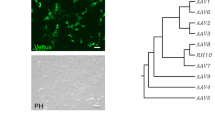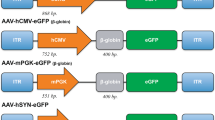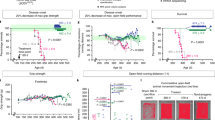Abstract
In order to determine the suitability of first generation adenoviral vectors for gene delivery into spinal cord white matter, four different titres of β-galactosidase-expressing adenovirus were injected into spinal cord white matter of adult rats. At titres ⩾106 p.f.u., transgene expression was extensive but severe tissue damage was observed in the form of axon degeneration, demyelination and astrocyte loss. When ⩽105 p.f.u. were injected, only low levels of axon degeneration and demyelination were observed. β-Galactosidase activity was detectable at 72 days and did not diminish significantly with time. The immune response in the spinal cord to 105 p.f.u. over 72 days was minimal, and indistinguishable from that to injection of buffer. A prominent immune response was observed when 107 p.f.u. was injected into the spinal cord of PVG rats, and when 105 or 107 p.f.u. was injected into AO rats. These results indicate that the immune response in PVG rats to βgal-expressing adenovirus is both strain and titre dependent. First generation adenoviral vectors, therefore, induce moderate and long-lived transgene expression with minimal tissue damage and immune response when an appropriate titre is injected into the low responder PVG rat strain, providing a suitable model for assessing the effect of gene delivery in models of spinal cord injury.
This is a preview of subscription content, access via your institution
Access options
Subscribe to this journal
Receive 12 print issues and online access
$259.00 per year
only $21.58 per issue
Buy this article
- Purchase on Springer Link
- Instant access to full article PDF
Prices may be subject to local taxes which are calculated during checkout




Similar content being viewed by others
References
Le Gal La Salle GL et al. An adenovirus vector for gene-transfer into neurons and glia in the brain Science 1993 259: 988–990
Davidson BL et al. A model system for in vivo gene transfer into the central nervous system using an adenoviral vector Nat Genet 1993 3: 219–223
Ridoux V et al. The use of adenovirus vectors for intracerebral grafting of transfected nervous cells Neuroreport 1994 5: 801–804
Byrnes AP, Rusby JE, Wood MJA, Charlton HM . Adenovirus gene transfer causes inflammation in the brain Neuroscience 1995 66: 1015–1024
Byrnes AP, MacLaren RE, Charlton HM . Immunological instability of persistent adenovirus vectors in the brain: peripheral exposure to vector leads to renewed inflammation, reduced gene expression, and demyelination J Neurosci 1996 16: 3045–3055
Byrnes AP, Wood MJA, Charlton HM . Role of T cells in inflammation caused by adenovirus vectors in the brain Gene Therapy 1996 3: 644–651
Geddes BJ, Harding TC, Lightman SL, Uney JB . Long-term gene therapy in the CNS: reversal of hypothalamic diabetes insipidus in the Brattleboro rat by using an adenovirus expressing arginine vasopressin Nature Med 1997 3: 1402–1404
Akli S et al. Transfer of a foreign gene into the brain using adenovirus vectors Nat Genet 1993 3: 224–228
Caillaud C et al. Adenoviral vector as a gene delivery system into cultured rat neuronal and glial cells Eur J Neurosci 1993 5: 1287–1291
Horellou P et al. Direct intracerebral gene-transfer of an adenoviral vector expressing tyrosine-hydroxylase in a rat model of Parkinsons disease Neuroreport 1994 6: 49–53
Durham HD et al. Toxicity of replication-defective adenoviral recombinants in dissociated cultures of nervous tissue Exp Neurol 1996 140: 14–20
Hermens WTJMC, Verhaagen J . Adenoviral vector-mediated gene expression in the nervous system of immunocompetent Wistar and T cell-deficient nude rats: preferential survival of transduced astroglial cells in nude rats Hum Gene Ther 1997 8: 1049–1063
Smith JG et al. Intracranial administration of adenovirus expressing HSV-TK in combination with ganciclovir produces a dose-dependent, self-limiting inflammatory response Hum Gene Ther 1997 8: 943–954
Baumgartner BJ, Shine HD . Targeted transduction of CNS neurons with adenoviral vectors carrying neurotrophic factor genes confers neuroprotection that exceeds the transduced population J Neurosci 1997 17: 6504–6511
Barkats M et al. Intrastriatal grafts of embryonic mesencephalic rat neurons genetically modified using an adenovirus encoding human Cu/Zn superoxide dismutase Neuroscience 1997 78: 703–713
Gimenez y Ribotta M et al. Prevention of motoneuron death by adenovirus-mediated neurotrophic factors J Neurosci Res 1997 48: 281–285
Gravel C, Gotz R, Lorrain A, Sendtner M . Adenoviral gene transfer of ciliary neurotrophic factor and brain-derived neurotrophic factor leads to long-term survival of axotomized motor neurons Nature Med 1997 3: 765–770
Riley DJ, Nikitin AY, Lee W-H . Adenovirus-mediated retinoblastoma gene therapy suppresses spontaneous pituitary melanotroph tumors in Rb± mice Nature Med 1996 2: 1316–1321
Shine HD et al. Neurotoxicity of intracerebral injection of a replication-defective adenoviral vector in a semipermissive species (cotton rat) Gene Therapy 1997 4: 275–279
Koozekanani SH, Vise WM, Hashemi RM, McGhee RB . Possible mechanisms for observed pathophysiological variability in experimental spinal cord injury by the method of Allen J Neurosurg 1976 44: 429–434
Means ED, Anderson DK, Waters TR, Kalaf L . Effect of methylprednisolone in compression trauma to the feline spinal cord J Neurosurg 1981 55: 200–208
Reier PJ, Houle JD . The glial scar: its bearing on axonal elongation and transplantation approaches to CNS repair Adv Neurol 1988 47: 87–138
Bunge MB et al. Characterization of photo-chemically induced spinal cord injury in the rat by light and electron microscopy Exp Neurol 1994 127: 76–93
Olby NJ, Blakemore WB . Primary demyelination and regeneration of ascending axons in the dorsal funiculus of the rat spinal cord following photochemically-induced injury J Neurocytol 1996 25: 465–480
Blakemore WF . Remyelination by Schwann cells of axons demyelinated by intraspinal injections of lysolecithin J Neurocytol 1975 4: 745–757
Keirstead HS, Blakemore WF . Identification of post-mitotic oligodendrocytes incapable of remyelination within the demyelinated adult spinal cord J Neuropathol Exp Neurol 1997 56: 1191–1201
Romero MI, Smith GM . Adenoviral gene transfer into the normal and injured spinal cord: enhanced transgene stability by combined administration of temperature-sensitive virus and transient immune blockade Gene Therapy 1998 5: 1612–1621
Blakemore WF, Crang AJ . The relationship between type-1 astrocytes, Schwann cells and oligodendrocytes following transplantation of glial cell cultures into demyelinating lesions in the adult rat spinal cord J Neurocytol 1989 18: 519–528
Franklin RJM, Crang AJ, Blakemore WF . Type 1 astrocytes fail to inhibit Schwann cell remyelination of CNS axons in the absence of cells of the O-2A lineage Dev Neurosci 1992 14: 85–92
Malo D, Skamene E . Genetic control of host resistance to infection Trends Genet 1994 10: 365–371
Matyszak MK, Perry VH . Demyelination in the central nervous system following a delayed-type hypersensitivity response to bacillus Calmette-Guerin Neuroscience 1995 64: 967–977
O’Leary MT, Bujdoso R, Blakemore WF . Rejection of wild-type and genetically engineered major histocompatibility complex-deficient glial cell xenografts in the central nervous system results in bystander demyelination and Wallerian degeneration Neuroscience 1998 85: 269–280
Kajiwara K et al. Immune responses to adenoviral vectors during gene transfer in the brain Hum Gene Ther 1997 8: 253–265
Harding TC et al. Switching transgene expression in the brain using an adenoviral tetracycline-regulatable system Nat Biotech 1998 16: 553–555
Stratford-Perricaudet LD, Makeh I, Perricaudet M, Briand P . Widespread long-term gene-transfer to mouse skeletal muscles and heart J Clin Invest 1992 90: 626–630
Wood MJA, Sloan DJ, Wood KJ, Charlton HM . Indefinite survival of neural xenografts induced with anti-CD4 monoclonal antibodies Neuroscience 1996 70: 775–789
Woolett GR, Barclay AN, Puklavec M, Williams AF . Molecular and antigenic heterogenetiy of the rat leucocyte-common antigen from thymocytes and T and B lymphocytes Eur J Immunol 1985 15: 168–173
Fukumoto T, McMaster WR, Williams AF . Mouse monoclonal antibodies against rat major histocompatibility antigens. Two Ia antigens and expression of Ia and class 1 antigens in rat thymus Eur J Immunol 1982 12: 237–243
McFarland HI, Nahill SR, Maciaszek JW, Welsh RM . CD11b (Mac-1): a marker for CD8+ cytotoxic T cell activation and memory in virus infection J Immunol 1992 149: 1326–1333
Robinson AP, White TM, Mason DW . Macrophage heterogeneity in the rat as delineated by two monoclonal antibodies MRC OX-41 and MRC OX-42, the latter recognizing complement receptor type 3 Immunology 1986 57: 239–247
Hunig T et al. A monoclonal antibody to a constant determinant of the rat T cell antigen receptor that induces T cell activation. Differential reactivity with subsets of immature and mature T lymphocytes J Exp Med 1989 169: 73–86
Paterson DJ et al. Antigens of activated rat T lymphocytes including a molecule of 50,000M detected only on CD4 positive T blasts Mol Immunol 1987 24: 1281–1290
Jefferies WA, Green JR, Williams AF . Authentic T helper CD4 (W3/25) antigen on rat peritoneal macrophages J Exp Med 1985 162: 117–127
Brideau RJ et al. Two subsets of rat T lymphocytes defined with monoclonal antibodies Eur J Immunol 1980 10: 609–615
Cantrell DA, Robins RA, Brooks CG, Baldwin RW . Phenotype of rat natural killer cells defined by monoclonal antibodies marking rat lymphocyte subsets Immunology 1982 45: 97–103
Brenan M, Puklavec M . The MRC OX-62 antigen: a useful marker in the purification of rat veiled cells with the biochemical properties of an integrin J Exp Med 1992 175: 1457–1465
Chambers WH et al. Monoclonal antibody to a triggering structure expressed on rat natural killer cells and adherent lymphokine-activated killer cells J Exp Med 1989 169: 1373–1389
Acknowledgements
The authors wish to thank Dr MM McMenamin and Dr WF Blakemore for comments on the manuscript, and Mr M Masih for expert technical assistance, and the MRC Cellular Immunology Unit for generously providing hybridoma supernatants. MT O’L holds a Wellcome Trust Research Career Development Fellowship. The work was funded by the Wellcome Trust.
Author information
Authors and Affiliations
Rights and permissions
About this article
Cite this article
O’Leary, M., Charlton, H. A model for long-term transgene expression in spinal cord regeneration studies. Gene Ther 6, 1351–1359 (1999). https://doi.org/10.1038/sj.gt.3300972
Received:
Accepted:
Published:
Issue Date:
DOI: https://doi.org/10.1038/sj.gt.3300972
Keywords
This article is cited by
-
Local adenoviral expression of Fas ligand upregulates pro-inflammatory immune responses in the CNS
Gene Therapy (2004)
-
Repeated intrathecal administration of plasmid DNA complexed with polyethylene glycol-grafted polyethylenimine led to prolonged transgene expression in the spinal cord
Gene Therapy (2003)
-
Adenoviral vectors: prospects for gene delivery to the central nervous system
Gene Therapy (1999)



